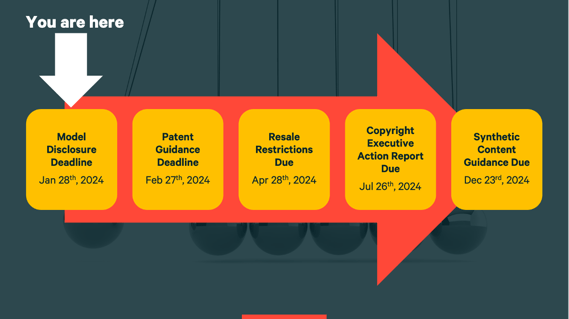Are you ready to comply with US Regulatory Artificial Intelligence reporting requirements?
You may remember the news around the AI Executive Order from November 2023. The wide-ranging order remains the most comprehensive U.S. Federal policy on the subject, and contains a multitude of subjects. We dug through and found key ways your business might (or might not) be affected. The first deadline, requiring businesses and individuals in possession or control of very large clusters and/or models to disclose them to the federal government, will take effect on or about January 28, 2024.

Do I have to disclose my model(s) to the federal government?
You probably do not need to disclose your AI model to the federal government. And if you do, you are in possession of one of the largest and most powerful Artificial Intelligence apparatuses in the world.
To qualify for mandatory disclosure, at the time of this writing, you’ll need either a model or a cluster capable of 10^26, or 10^23 if you’re dealing with biological data, floating-point operations. For perspective, Meta’s LLaMA uses 65B parameters, or 65x10^9, meaning it falls 14 orders of magnitude shy of needing to be reported if you’re using it.
Who is this really impacting?
It is hard to say for sure since not everyone is disclosing what they have built, but it’s safe to say it is going to be a short list. These companies would have to be on the bleeding edge of this technology and well-financed. As an example, GPT-4, OpenAI’s premier consumer-facing model, uses one trillion parameters, or 10^12, which is still substantially shy of the federal requirement.
The group of candidates with the capacity for this computing power is currently small and is expected to stay that way. This group is likely to be concentrated in industries outlined in the executive order, such as materials sciences, biological sciences, or those dealing with intricate data like image or video processing. Furthermore, although companies are obligated to disclose such information to the government, they may not be prepared to share it with the public.
What's next on the horizon?
By the end of February 2024, the government will issue guidance on how inventorship will be assigned for products developed in part or in whole by AI. At present, there seems to be a hodgepodge of different interpretations and schemes based on terms of service, as well as lawsuits, bandying about in the realm of intellectual property.
It's crucial to emphasize that the initial set of guidelines will specifically address patents, and recommendations for copyright will follow in July. This implies that we might have only one aspect of the puzzle for a few months.
Want to stay in the loop on the latest AI regulation news? Subscribe to Concord’s blog!
Want to get the most out of your AI? Let’s chat!
